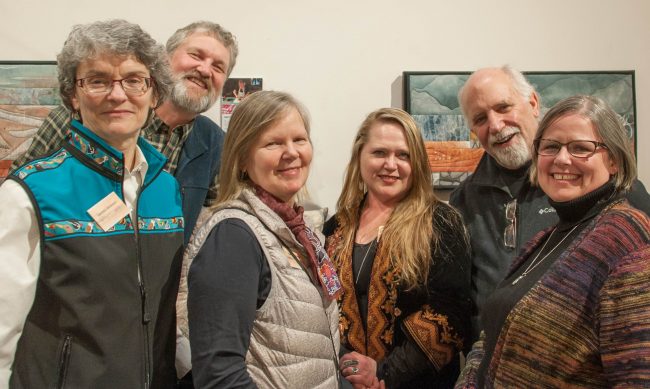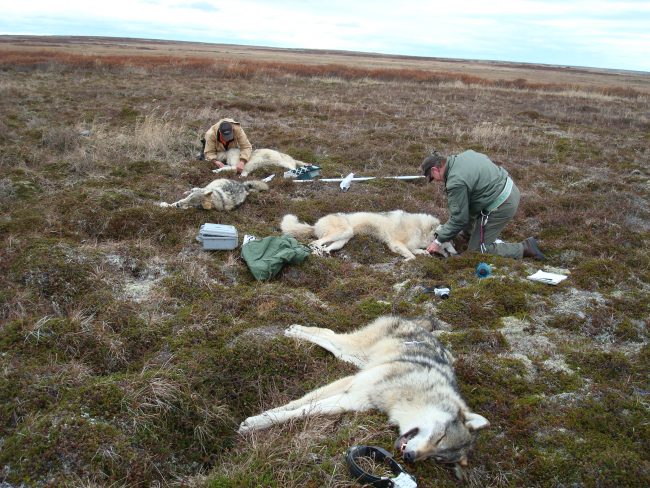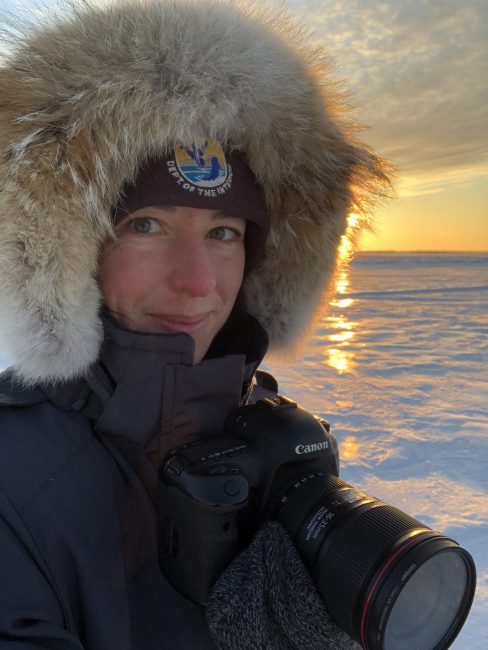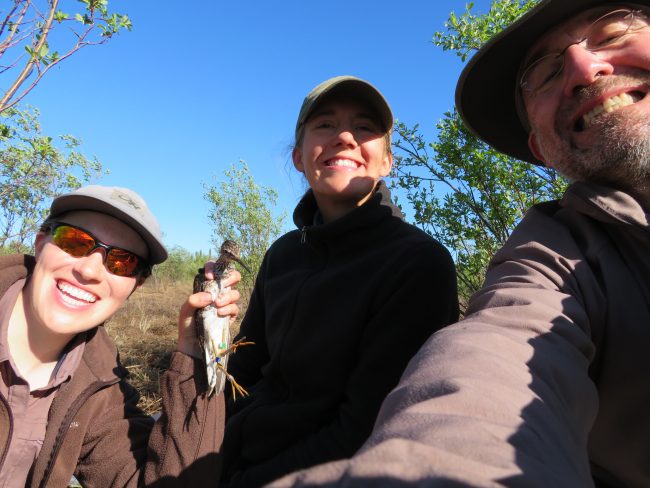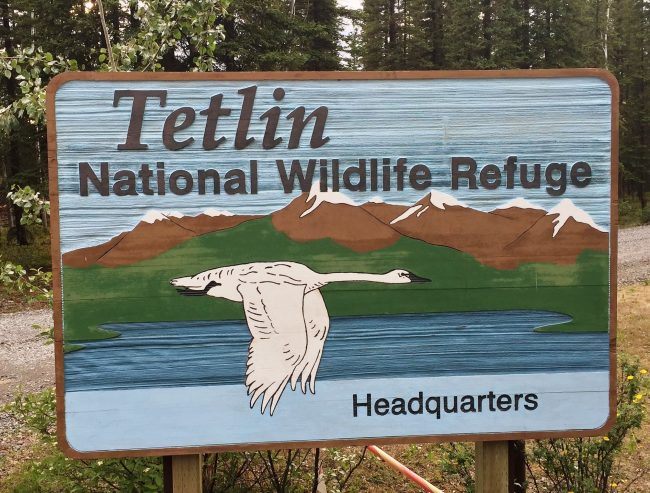The 5th annual Art in the Arctic, February 27, showcasing birds of the Arctic Refuges was a sparkling event well supported by Friends. Two of the six featured artists are Friends members – Laurel Devaney and Amy Mackinaw. Friends Patti Picha and Judy Williams worked the Friends Outreach table with Frank Williams photographing the event. 
Numbers were down some from last year with 125 attendees due probably to the biting cold but a good time was had by all. This is a great event for bringing in a diverse crowd and softly conveying refuge messages and information about the 200 bird species that use the northern refuges. This event is run by Fairbanks based refuges – Arctic, Yukon Flats and Kanuti. 
Two days later, Arctic Refuge’s 2019 Artist in Residence, Michael Boardman, gave a talk and led a drawing workshop for 14. Boardman has widely shared his experiences on the Arctic Refuge with over a dozen audiences both here in Alaska and in his home state of Maine. Kudos to the northern refuges for so effectively using art to broaden support and appreciation for wild lands and wildlife.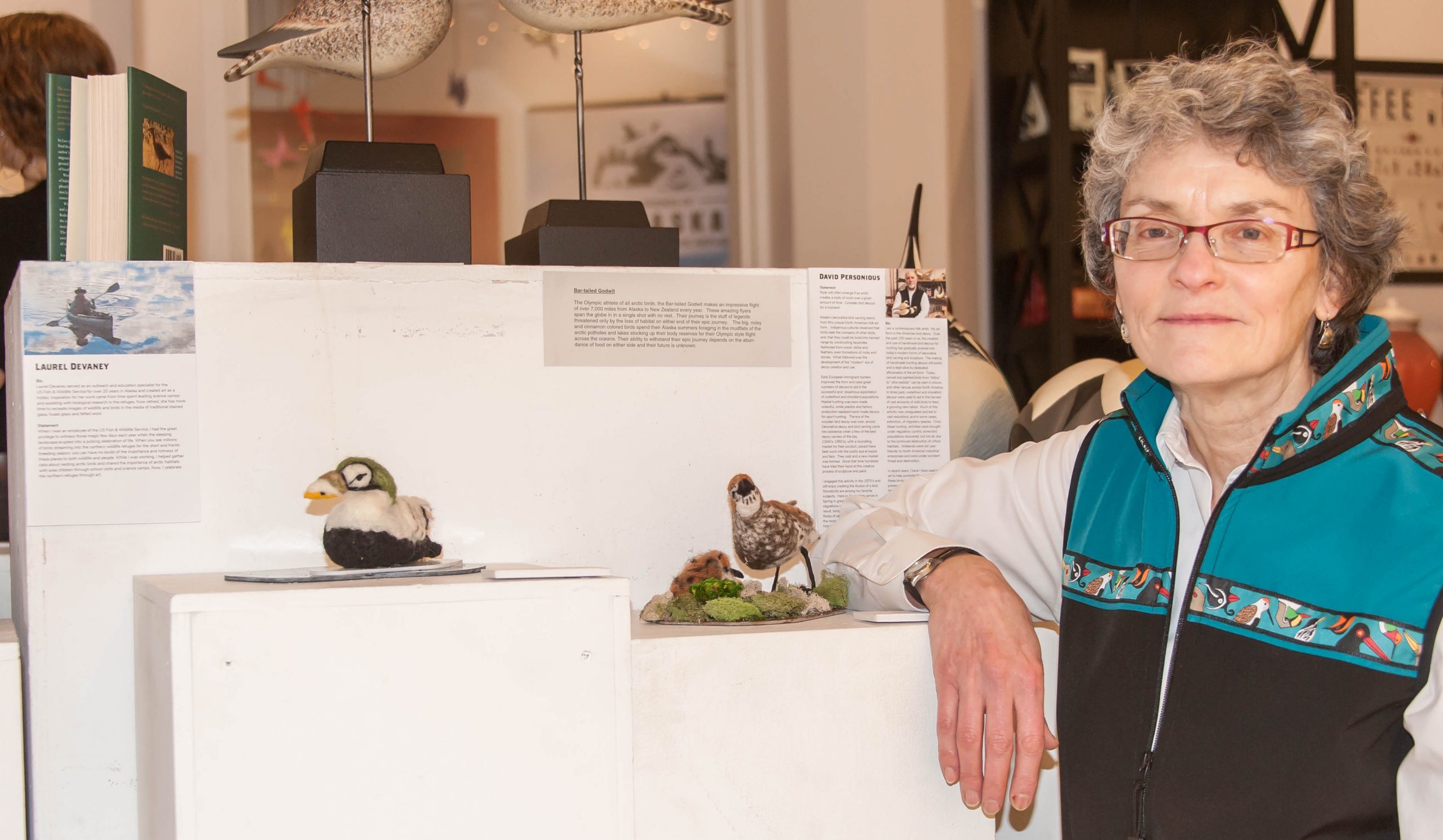
Author: Editor Friends of AK NRWs
Can wolf predation be good for caribou?
By John Morton, retired USFWS biologist
I called Pat Walsh, the Supervisory Biologist at Togiak National Wildlife Refuge, to ask him about an interesting article he published this past year in the journal Rangifer. Titled “Influence of wolf predation on population momentum of the Nushagak Peninsula caribou herd, southwestern Alaska”, it essentially asks if wolf predation can be good for caribou.
Walsh laid out a fascinating ecological story. During 1997−2007, the nonmigratory caribou herd on the Nushagak Peninsula, located within Togiak Refuge, declined from 1,400 to 500 individuals. Walsh, working closely with his Alaska Department of Fish and Game State colleague, James Woolington, investigated the time budgets of three wolf packs that used the peninsula during the following five years (2007−2012) to figure out if wolves were responsible for the herd’s decline. During their study, wolf predation steadily increased on the caribou; however, contrary to expectations, the caribou population steadily increased as well!
These two field biologists tracked 20 GPS- and VHF-collared wolves during their study. They found that only one of three packs regularly used the peninsula. This pack, known as the Ualik Lake pack, spent 35% of its time there. Its use of the peninsula was disproportionately high in late summer and fall, disproportionately low in winter, and proportional during the caribou calving season in early summer. The overall wolf use of the Nushagak Peninsula increased in direct response to increasing caribou abundance. Walsh and Woolington concluded that, in this instance, wolf predation was not driving caribou population dynamics. Instead, the caribou population was the driver and wolves were simply responding to an increasingly abundant food. The Nushagak herd had previously declined, then increased, due to internal demographic factors apparently unrelated to predation (see graph).
Not all wolf-caribou interactions are the same, and that the geography of the Nushagak Peninsula makes this situation somewhat unique. The 800 mile2 peninsula is narrow enough that this single wolf pack was able to establish its territory near the head of the peninsula, and thus defend the area from other wolves on the mainland. So, as the Nushagak caribou population increased, the Ualik Lake wolf pack spent more time preying on them, and concurrently (and ironically) spent more time protecting them from predation by other wolves! Life is not always as it seems. 
Since the conclusion of their study in 2012, the caribou population has continued to increase to the point that habitat damage is evident. In short, high numbers of caribou may be eating themselves out of house and home. Wildlife managers have attempted to address this by increasing human harvest through several regulatory changes, but lack of snow in recent winters has prevented snowmachine access, which is the primary transport used by hunters there. Walsh told me, “We think it’s possible that the Nushagak Peninsula caribou will face winter food shortages in the near future, and may simply walk away”. Should this happen, local villages could lose an important subsistence resource.
Although wolf predation has not served as a very effective population control for caribou, it is certainly working in the direction of management. And to answer the question as to whether wolves can be beneficial for caribou, it appears that in this case, it could be that the protection resident wolves provide may be too much. As Walsh sees it, a bit more predation might prevent degradation of caribou habitat, which could help sustain the caribou population itself.
Walsh and Woolington wrote that the principal reason they conducted their study was to assess whether wolf population control was necessary to prevent the population decline in this herd. Had predator control been instituted at the onset of this study (as requested by local management committees), it is reasonable to believe that the caribou population would have increased as it did. However, these two seasoned biologists also point out “stakeholders might have incorrectly concluded that wolf control caused the caribou population response.” This case illustrates the importance of careful thought and having sufficient data for both ungulate and predator populations before invoking predator control.
2020 March Advocacy Report
By: David Raskin, Friends President The Arctic Refuge drilling proposal and Izembek Refuge battles continue, and we expect major events in the very near future.
The Arctic Refuge drilling proposal and Izembek Refuge battles continue, and we expect major events in the very near future.
Arctic National Wildlife Refuge
The Secretary of Interior stated that the Record of Decision (ROD) is expected soon. Machinations continue behind the scenes regarding the amount of recoverable oil below the Coastal Plain. There are indications that the dry wells drilled in the past near the edges of the Coastal Plain may discourage the major oil companies from bidding on leases when the lease sale opens. That may open the door for smaller companies to buy leases at bargain basement prices. The Administration’s inflated projections for oil revenue from the Arctic oil seem more far-fetched as information dribbles out. Also, the USFWS announced a comment period on the excellent study on the potential impacts of seismic exploration on denning polar bears (federal register notice). Please send in your comments by April 20 and register your concerns about the dangers of seismic exploration to the denning of the endangered Beaufort population of polar bears,
Our conservation and Native Alaskan partners continue their highly successful outreach events throughout the country, and there have been many more great pieces in various media. The campaign’s meetings with executives of oil companies and financial institutions concerning the dangers of Arctic drilling and the financial risks of supporting such efforts continue to produce impressive results. Bernadette Demientieff, Executive Director of the Gwich’in Steering Committee, and the Arctic Refuge Defense Campaign (https://www.arcticrefugedefense.org) have succeeded in convincing most of the major banks and financiers to adopt policies against providing financing for oil and gas projects, with special attention to the Arctic. We continue to make progress in the decades-long battle to save and preserve the Arctic Refuge and its subsistence and cultural values!
Izembek National Wildlife Refuge
The federal defendants in our federal lawsuit to stop the land transfer and road filed their reply brief last week. It contains a rehash of most of the same arguments that the Federal Court rejected in our previously successful suit. Although we await a ruling from the Court, we are optimistic that we shall again prevail. We will provide updates as this lawsuit works its way through the legal process.
Kenai Predator Control and Hunting Regulations
The proposed Kenai Refuge predator control regulations still have not been released, but we continue to expect them soon. It is likely that the new regulations will not only allow hunting of brown bears over bait, as well as loosened restrictions on hunting in the Skilak Wildlife Recreation Area and 4-wheel drive access to frozen lakes, but we expect additional draconian measures to be included in the final version. It appears that there will be a 60-day comment period, but no public hearings. All of our conservation partners are closely monitoring this process and are preparing to take whatever action is necessary to stop this assault on Kenai Refuge wildlife.
Ambler Road
We are not aware of any significant development on the proposed 211-mile long Ambler industrial road even though it is on an “unprecedented, extreme fast track,” according to a BLM official.
Arctic to Attu: A Photographer’s Tour of Six Alaska Wildlife Refuges
Lisa will be speaking to us at the Anchorage meeting: our other gatherings will join via Zoom Meetings or you can join from home (see below).
- Anchorage: Fish & Wildlife Service Regional Office, 1011 E. Tudor
- Fairbanks: Watershed School 4975 Decathlon
- Homer: Islands and Ocean Visitor Center, 95 Sterling Highway
- Soldotna: Kenai National Wildlife Refuge Visitor Center, Ski Hill Road
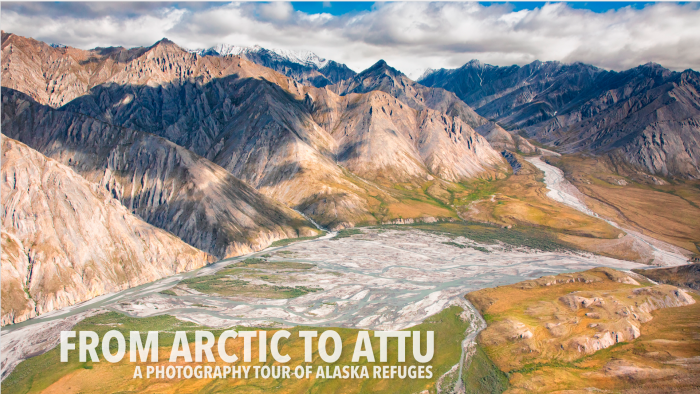
Lisa Hupp will share her experiences behind the lens photographing Alaska’s refuges. “I love how photography can demand close attention and devotion to place,” Hupp says. “It’s a way to see and share the world, whether you take photos on a phone or with a backpack full of equipment. Alaska’s national wildlife refuges are places of endless possibility for photographers, from dramatic and vast landscapes to charismatic wildlife. These refuges are big, wild and remote; photography can help us to tell their stories.”
Hupp is the Communications Coordinator for National Wildlife Refuges in Alaska. You can see some of her images and read how she gets those amazing shots here.
Download Lisa’s presentation: Arctic to Attu (PowerPoint .pptx file)
Missed the meeting? Watch a recording of the meeting below:
2020 February Advocacy Report
By: David Raskin, Friends Board President The calm before the storm! The Arctic Refuge drilling proposal continues front and center on the national stage, and the administration’s numerous assaults on the environment continue to be bogged down under the pressures of time, resources, and inadequate scientific studies. However, we expect major events in the very near future.
The calm before the storm! The Arctic Refuge drilling proposal continues front and center on the national stage, and the administration’s numerous assaults on the environment continue to be bogged down under the pressures of time, resources, and inadequate scientific studies. However, we expect major events in the very near future.
Arctic National Wildlife Refuge
There are rumors concerning DOI plans to sell leases for oil and gas development in the Coastal Plain of the Arctic Refuge. The Record of Decision (ROD) continues to be delayed for unannounced reasons and is now expected sometime in March. Since the lease sale had been planned for December 2019, the delay of the ROD and the necessary waiting periods after its release have pushed any possible lease sale farther into the Spring at the earliest.
There is no word about plans for seismic exploration. which likely cannot occur before the 2020-21 winter, if at all. However, SAExploration has been sold to a Norwegian company. The implication of this transfer for exploration in the Coastal Plain is unclear.
Our conservation and Native Alaskan partners continue to hold more successful outreach events throughout the country, and there have been many great pieces in various media. The campaign’s meetings with executives of oil companies and financial institutions concerning the dangers of Arctic drilling and the financial risks of supporting such efforts are producing impressive results. Bernadette Demientieff, Executive Director of the Gwich’in Steering Committee, and the Arctic Refuge Defense Campaign continue to spearhead this increasingly successful campaign. Major investment managers and banks are joining the ranks of those warning against investing in oil and gas projects, with special attention to the Arctic. We continue to make progress in the decades-long battle to save and preserve the Arctic Refuge and its subsistence and cultural values!
Izembek National Wildlife Refuge
There was no significant development in the suit filed on August 7, 2019 in federal district court that names Friends as the lead plaintiff along with eight conservation partners. The Court approved the unopposed intervention of the State of Alaska. We have not received a ruling from the Court, and we will provide updates as this lawsuit works its way through the legal process.
Kenai Predator Control and Hunting Regulations
The proposed Kenai Refuge predator control regulations have not been released, but we continue to expect them soon. It is likely that the new regulations will not only allow hunting of brown bears over bait, as well as loosened restrictions on hunting in the Skilak Wildlife Recreation Area and 4-wheel drive access to frozen lakes, but we expect additional draconian measures to be included in the final version. It appears that there will be a 60-day comment period, but no public hearings. All of our conservation partners are closely monitoring this process and are preparing to take whatever action is necessary to stop this assault on Kenai Refuge wildlife.
Ambler Road
We are not aware of any significant development on the proposed 211-mile long Ambler industrial road even though it is on an “unprecedented, extreme fast track,” according to a BLM official.
Yellowlegs are noisy, but we’d sorely miss them if they disappear…
By Chris Harwood, Wildlife Biologist, Kanuti National Wildlife Refuge
I’ve conducted literally thousands of songbird surveys in my almost 30 years with Alaska Refuges. On Kanuti Refuge, the listening conditions at my survey count points are typically excellent—little to no wind and, of course, no car traffic. Really, the primary aural challenge is filtering out the species and individuals I’ve already identified and counted from possibly new ones.
In the boreal forest, however, there is one natural distraction that tests my ability to concentrate during surveys (and even tries my patience!). Songbird surveys in the Interior often coincide with late incubation, hatch, or brood rearing of Lesser Yellowlegs…and nothing can ruin a songbird survey quite like a Lesser Yellowlegs vociferously defending its nearby nest or chicks.
Breeding (especially, successfully hatching) yellowlegs have little competition where alarm-calling stamina (and volume) and defensive mobbing and distraction displays are concerned. Just try and hear that distant, soft-singing Blackpoll Warbler with a yellowlegs flitting in front of your face and screaming in your ear because you’re too close to its chicks you’ll never see.
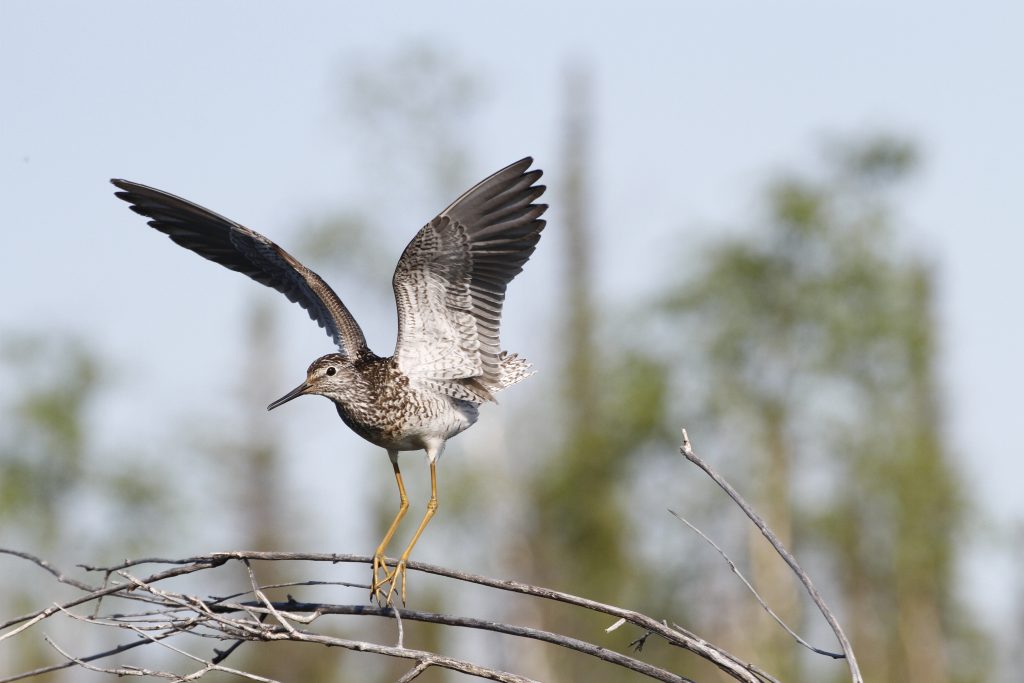
Well, it now seems that such survey distractions might be getting less common—and that’s not a good thing. The Lesser Yellowlegs population has declined by 70–80% over the past four decades across boreal North America. And it’s not just a Canadian yellowlegs problem. We believe Alaska yellowlegs are declining, too.
So, why the decline? Well, there’s a team of Alaskan and Canadian researchers who are now looking into threats to yellowlegs throughout their annual life cycle, including legal and illegal harvest in the tropics. Click here to read their report.
Through near-annual survey work from our administrative cabin along the Kanuti River, I have determined that Lesser Yellowlegs are still pretty common on a nearby study area. Given that this major yellowlegs research project lacked a study site in interior Alaska proper, I proposed that Kanuti Refuge join the boreal-wide “Yellowlegs Team” in 2018. So we purchased 10 GPS transmitters to track where some of our yellowlegs migrate and overwinter so possible threats along their annual route could be assessed.
We invited Laura McDuffie with USFWS Migratory Bird Management to the cabin in June 2019 to help us capture yellowlegs and deploy our transmitters (Laura’s M.S. thesis includes analysis of yellowlegs movements). The timing of Laura’s arrival was perfect—yellowlegs eggs started hatching that day!
We captured 13 adult yellowlegs over six exhausting days and marked them all with uniquely coded leg-flags (green with two white characters) and one blue band to denote them as “Kanuti” birds. Ten adults also received GPS transmitters. In the fall, we also contributed funding for the project’s genetics work.
Once they departed Kanuti Refuge, all but one of our 10 transmittered yellowlegs stopped initially and briefly on Yukon Flats Refuge before heading down the Central Flyway through the Great Plains of southern Canada. As of 20 August 2019, six of the yellowlegs had fanned out to points farther south, including Florida, Mexico, Cuba (2 birds), Ecuador and Peru. 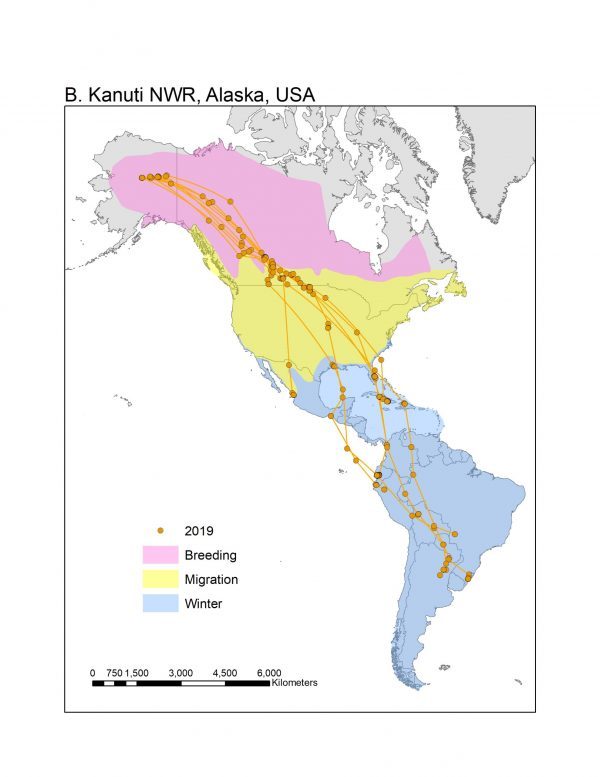
Four of the 10 transmitters were still reporting as of 1 January 2020. Two of our birds are wintering in southeastern Brazil, another in northeastern Argentina, and the fourth in western Mexico.
This spring, a field assistant and I will return to the cabin with the hope of re-sighting any of the birds marked last June. After hatch, we will also attempt to mark new birds as part of an ongoing effort to study adult survival. The Yellowlegs Team is currently assessing whether more transmitter work is needed in coming years.
Kanuti Refuge hopes to remain an integral member of this amazing continent-wide research partnership as we strive to better understand what it takes to ensure Lesser Yellowlegs remain common.
Tetlin Refuge’s Trumpeter Swans: A Comeback Story
By Poppy Benson
One of the delights of traveling on the Alaska Highway through the Tetlin National Wildlife Refuge is spotting graceful trumpeter swans on refuge lakes and ponds. The trumpeter, the largest waterfowl species in North America, is such an iconic Tetlin species that it was chosen for their logo used on their signs and publications. It is hard to believe that at one time, no trumpeter swans could be found on what was to become the Tetlin Refuge. 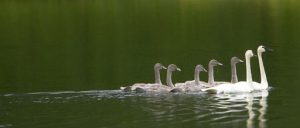
Trumpeter swans were nearly decimated from the United States for the skin and feather trade between 1600 and the 1800s. In 1935 only 69 individuals were known to exist in the US although others may have survived in remote parts of Alaska and Canada. No trumpeter swans were documented in the Upper Tanana Valley where the refuge is located until 1980. In 1985, the aerial swan survey recorded just 97 swans and 13 broods on and around the Tetlin National Wildlife Refuge. Since then the population has exploded. In 2015, the last swan survey, there were almost 2000 swans! This is consistent with swan recovery throughout the country. Nation-wide swan populations have increased exponentially at a rate of 6.2% per year between 1968 and 2010. Over half of North America’s trumpeter swans breed in Alaska.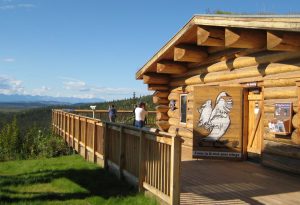
Will this growth continue or has the swan population on the refuge peaked or is it about to peak? The number of broods has been declining since it peaked at 147 in 2005. The 2015 survey found that a greater proportion of adult swans are not breeding successfully. Could all the available wetland breeding habitat already be occupied by swans? This year’s swan survey should help answer some of those questions. The data presented here is from “Thirty Years of Swan Surveys at Tetlin National Wildlife Refuge (1985-2015)” by Kristin DuBour. You can access it here.
Volunteer Update
Friends of Alaska National Wildlife Refuges is working hard to get some volunteer opportunities for our members. The refuges are submitting requests for volunteers and funding during January. At our February Board meeting, we will be approving as many of their requests as possible. Any Volunteer Opportunities for 2020 will then be listed on our website by February 16 so stay tuned!
Meanwhile there are other opportunities to offer your skills and knowledge by contacting a refuge directly. These projects are not a part of Friends, but are general ongoing needs of various refuges. Below is a list provided by Yukon Flats. There will be others of this type on more refuges and when we have information, we’ll try to get it out to you. Contact Jimmy_fox@fws.gov directly if interested.
· Continue lynx capture/monitoring/snowshoe hare monitoring project
· Conduct mallard banding project at Canvasback Lake
· Implement annual scoter and scaup aerial survey
· Conduct annual waterfowl brood surveys
· Operate trail camera and snow monitoring program
· Conduct annual stick nest survey and keep active nest locations in NIFC Known Sites Database
· Implement annual loon survey
· Conduct annual trumpeter swan survey
· Implement annual Dall’s sheep survey in the White Mtns
· Provide aerial survey support for Draanjik River sheefish research project (2020-2022)
· Support Elodea eradication efforts in the Interior
· Conduct invasive species surveys in villages after consultation with tribes
· Inspect John Herbert’s Village structures, make necessary repairs, and identify deferred maintenance needs; and develop interpretative panel to display on site
· Engage students and create entries for the USFWS Migratory Bird Calendar in Fort Yukon
· Staff Outdoor Days event at UAF in Fairbanks
· Staff Bird Watch event at Creamer’s Refuge in Fairbanks
· Conduct USFWS waterfowl hunting clinic in Birch Creek
· Create salmon art and conduct fish wheel decoration contest
· Staff the USFWS Dragonfly Days event in Fairbanks
· Conduct an event in association with the 4th of July Parade in Fort Yukon
· Staff the Golden Days Parade float in Fairbanks
· Engage students at career fairs in Fort Yukon
· Participate in, and support, the National Native Youth Congress
· Revise fire ecology language for Web page and other outreach materials
· Create new content for kiosks in Circle and Fort Yukon
· Assess condition of kiosks and panels at Dalton Highway MP86 and Yukon River Crossing
· Work with tribes to install invasives prevention signs at major points of entry
· Investigate purpose and feasibility of marketing, in partnership with others, the LEO Network
· Develop refuge staff poster for rural communities
· Create and distribute biological reports to villages and post highlights on Web site and Facebook
· Work with IARC to develop messages for joint outreach materials and efforts
· Finalize, print and distribute new refuge brochure (and replace stock on shelves)
· Create and distribute CATG/USFWS fact sheet about AFA
· Conduct routine maintenance at Scoter Lake Fueling Site and other avgas tanks
· Continue to oversee and assist with construction of Fort Yukon bunkhouse
· Contract and administer construction of fence and gates for Fort Yukon bunkhouse
· Develop contracts for construction of solar systems for Fort Yukon Warehouse, Bunkhouse and Fairbanks Hangar
· Contract for insulating the Fort Yukon warehouse
· Repair roof on Canvasback Lake cabin
· Develop use policies for Fort Yukon facilities and equipment (and distribute/post)
· Develop calendar of routine maintenance for all assets
· Perform routine cleaning of Fort Yukon cabin and outhouse and keep essentials stocked
· Replace fuel meter and access system on hangar av gas tank
· Compile hangar repairs task order for Maintenance Action Team
· Maintain all field equipment
Adventures with a unique Alaska shorebird: the Bristle-thighed Curlew
Please join us on Tuesday, January 21, 2020, 5-6 pm (AKDT), for our Friends January membership meeting with featured guest speaker, Kristine Sowl.
Wildlife Biologist Kristine Sowl worked on a Bristle-thighed Curlew nesting ecology study in the Andreafsky Wilderness of the Yukon Delta National Wildlife Refuge in the summers of 2010 to 2012. The curlew proved to be an elusive, difficult, and fascinating species to study. Her presentation will talk about her experiences during that project. Kristine Sowl has spent over 25 years working as a field biologist on public lands in Alaska, including Yukon Delta, Izembek, and Yukon Flats National Wildlife Refuges, and summer seasonal jobs at the Alaska Peninsula National Wildlife Refuge, Aniakchak and Cape Krusenstern National Monuments, and Bering Land Bridge National Preserve. She moved from Bethel to Homer a year ago and now spends her time helping Alaska’s wildlife refuges plan their biological programs.
Kristine will be at the Homer meeting; our other gatherings will join via Zoom Meetings.
- Fairbanks: Watershed School 4975 Decathlon
- Anchorage: Fish & Wildlife Service Regional Office, 1011 E. Tudor
- Homer: Islands and Ocean Visitor Center, 95 Sterling Highway
- Soldotna: Kenai National Wildlife Refuge Visitor Center, Ski Hill Roaddownload Kristine’s presentation and follow along:
2020 January Advocacy Report
By: David Raskin, Friends Board President
The Arctic Refuge drilling proposal continues front and center on the national stage, and the administration’s numerous assaults on the environment remain bogged down under the pressures of time, resources, and inadequate scientific studies!
Arctic National Wildlife Refuge
There is some news concerning DOI plans to sell leases for oil and gas development in the Coastal Plain of the Arctic Refuge. The Record of Decision (ROD) continues to be delayed for unannounced reasons and is now delayed until at least sometime in January. Since the lease sale had been planned for December 2019, the delay of the ROD and the necessary waiting periods after its release have pushed any possible lease sale farther into February at the earliest.
There is no word about plans for seismic exploration, which likely cannot occur before the 2020-21 winter, if at all. A recent report published in the Journal of Wildlife Management describes the potential impacts of various seismic scenarios. Even the most restrictive alternative would risk some polar bear mortality. So far, we have not seen a proposed plan for exploration. The warming arctic temperatures have narrowed the window of opportunity for such activities on frozen tundra. However, the State of Alaska appears to be moving forward with seismic exploration on State lands immediately adjacent to the Canning River in the Arctic Refuge.
Our conservation and Native Alaskan partners continue to hold successful outreach events throughout the country, and there have been many great pieces in various media. The campaign’s meetings with executives of oil companies and financial institutions concerning the dangers of Arctic drilling and the financial risks of supporting such efforts are producing impressive results. Bernadette Demientieff, Executive Director of the Gwich’in Steering Committee, is spearheading this campaign and has recently received national recognition for her great work. We will win this latest in the decades-long battle to save and preserve the Arctic Refuge and its subsistence and cultural values!
Izembek National Wildlife Refuge
There is no significant development in the suit filed on August 7, 2019 in federal district court that names Friends as the lead plaintiff along with eight conservation partners. We have not received a ruling from the Court, and we will provide updates as this lawsuit works its way through the legal process.
Kenai Predator Control and Hunting Regulations
The proposed Kenai Refuge predator control regulations have not been released, but we continue to expect them soon. It is likely that the new regulations will allow hunting of brown bears over bait, as well as loosened restrictions on hunting in the Skilak Wildlife Recreation Area and 4-wheel drive access to frozen lakes. It appears that there will be a 30-day comment period, but no public hearings. Recently, the State of Alaska and the Safari Club filed their motion for summary judgment challenging the Kenai National Wildlife Refuge’s rule that bans brown bear baiting (among other things). The Friends and other organizations are intervenors in this lawsuit and are closely following these developments. If the DOI adopts new predator guidelines, this lawsuit may be rendered moot.
Ambler Road
The has not been any significant development on the proposed 211-mile long Ambler industrial road even though it is on an “unprecedented, extreme fast track,” according to a BLM official. Trustees for Alaska assembled detailed, comprehensive comments on the DEIS that were submitted on behalf of numerous organizations, including Friends. We await information on the comments that were submitted and the issuance of a Final EIS. As with the many hurried and poorly supported BLM assaults on public lands, this process seems to have slowed.
